Face and body painting have been important parts of Amazonian culture for centuries. Face painting in particular has played an important part in hunting, warfare, and courtship. Traditional designs could designate status and identity. A man’s facial paint can give him courage and power; a woman’s facial paint gives her … well, sex appeal. Face painting also played important social roles; among the Shipibo, for example, painting a man’s face in traditional designs was a job performed only by women. Here are some examples:
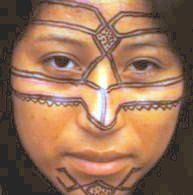 |
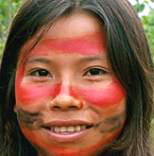 |
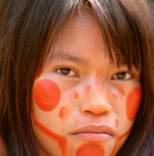 |
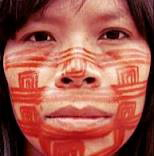 |
 |
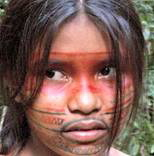 |
Along with wet charcoal for black marks, two plants have been traditionally used for face and body painting — achiote (Bixa orellana) and huito, genipa, or jagua (Genipa americana).
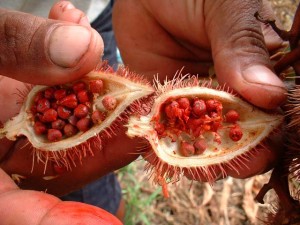 |
| Achiote (Bixa orellana) |
The bright red spiny achiote fruit contains numerous small red seeds which, when crushed, produce a bright red-orange dye, containing the carotenoid pigment bixin. The leaves have been used to treat skin infections and as a vaginal antiseptic; the red paste may be applied around the ankles as a tick repellant. But the predominant use of the plant is as a dye for cloth, hair, and skin, and — often under the name annatto — as a virtually tasteless food colorant. In Mexican cooking, recado rojo or achiote paste combines annatto, oregano, cumin, clove, cinnamon, black pepper, allspice, garlic, and salt, giving dishes a distinctive flavor and red coloring. Annatto is widely used in Filipino, Latin American, and Caribbean cooking.
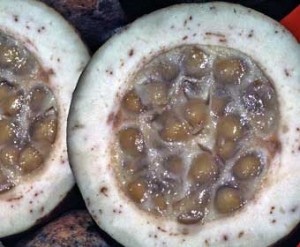 |
| Huito (Genipa americana) |
Huito is cultivated for its thick-skinned edible fruit, which, when ripe, is made into drinks, jelly, and sherbet and used in ice cream. Cooking the fruit with brown sugar and aguardiente makes a very palatable desert. Huito is rich in manitol, genipin, tannins, and caffeine; the tannins give the juice an astringent effect.
The juice of the immature fruit is clear, but it contains an irioid of genipin which oxidizes to a very dark blue color. This juice is used to decorate clothes and pottery as well as human skin. For example, the Shipibo use crushed huito fruits to put their traditional designs on natural cotton — either undyed or dyed in mahogany bark, which gives the cloth a distinctive brown colour — using a pointed piece of chonta palm (Euterpe spp.) or an iron nail. The paint turns dark blue or black as it is exposed to air.
Once skin has been dyed with huito, the color remains for about two weeks. Indeed, a number of companies have begun offering jagua tattoo paint as an alternative to henna for a semipermanent tattoos.

- Previous Post: Dolphins
- Next Post: Beings of the Air
- More Articles Related to: Indigenous Culture, Plant Medicine, The Amazon



Could anyone tell me how I can actually make body paint form anatto?
I’ve got the seeds and the power
Thanks
Thanks for the information on Achiote. I saw these seeds being used in cooking and face painting as a child in Trinidad. Our neighbour had the tree. But we did not call it Achiote. Do you have the local name for it? Also I did not know you could use it as a textile dye as well. I do a bit of dying and will like to know the form in which it is available and where I can get it
Thanks
To make body paint from anato you mix it with some oil, like coconut oil. It will stay put, but will stain everything it witches. The skin will be stained yellow after you wash it out.
It can be used for textiles. It will prod an yellow-orange color. But I don’t know how to fix it.